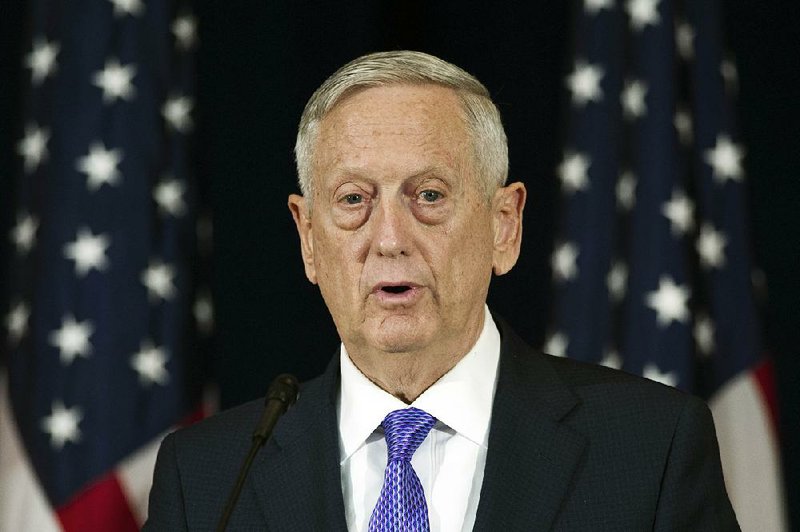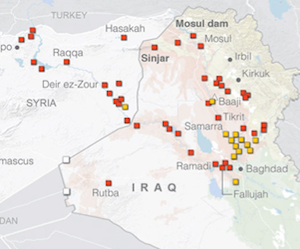MUNICH, Germany -- The Pentagon is readying itself for an increasingly complex battlefield in northern Syria, where U.S.-backed forces, pro-Syrian government troops and Russian jets will likely all be fighting near one another.
Speaking to reporters on his way to Germany on Monday to meet with European allies, U.S. Defense Secretary James Mattis spoke broadly about the U.S. military's future operations against the Islamic State in the Euphrates River Valley, adding that it will take "more precision" to stave off any incidents between the disparate forces operating there.
"You have to play this thing very carefully," Mattis said. "The closer we get, the more complex it gets."
The strip of the Euphrates River Valley that runs through northeastern Syria has turned into one of the last Islamic State redoubts as the group nears defeat in the Iraqi city of Mosul and as U.S.-led forces move to encircle the group's stronghold in Raqqa. While the Pentagon has eyed the region as the next place to attack the militants, Syrian government forces and Iranian-backed militias have also made a concerted effort to move into the area.
To avoid the seemingly inevitable collision between U.S.-backed fighters and pro-Syrian government forces, including their respective air support, Mattis indicated that the Euphrates River Valley would be carved up into "deconfliction" areas. The zones would be marked by easily identifiable parts of the river valley, such as towns and geographic features on the map, he said.
"As long as it's worked out by the commanders and enough people know about it in sufficient time, there are ways that have proven that we can do this," Mattis said. The retired four-star Marine general suggested that with so many forces operating in the same area, deconfliction efforts would have to be worked out differently than they have in the past, though how exactly is unclear.
Currently, there are a number of communication lines between Russian and U.S. forces, including one that runs into the U.S.-led coalition's main operations center in Qatar and another that connects the commander of U.S. forces in Iraq and Syria, Lt. Gen. Stephen Townsend, to his Russian counterpart in Syria.
"The deconfliction lines, through all of these contentious months that we've been through, have never gone down," Mattis added.
The communication channels between the United States and Russia, Mattis said, have helped U.S. forces stay "focused" on fighting the Islamic State and have kept the United States from a widening role in the 6-year-old conflict that has claimed hundreds of thousands of lives and displaced millions.
"We just refuse to get drawn into the Syrian civil war," Mattis said. "We try to end that through diplomatic means."
Just hours after his remarks, however, the White House released a statement saying that it had reason to believe Syrian President Bashar Assad's forces were preparing for a chemical-weapons attack and that his military would "pay a heavy price" if it conducted any such strike.
In April, President Donald Trump ordered a cruise missile strike in response to what Washington claimed was a gas attack carried out by Assad's forces that killed nearly 90 people. Assad denied any such attack.
In addition to the White House threat, a series of incidents in recent weeks -- including the downing of a Syrian government jet and two Iranian-made drones by U.S. aircraft -- appear to suggest the opposite of Mattis' claims. The series of air attacks, taken in self-defense by U.S. forces, according to the Pentagon, occurred as pro-Assad forces threatened or approached U.S.-backed Syrian fighters.
After the shooting down of the Syrian jet, Russia said it would treat U.S. aircraft west of the Euphrates as "targets," but since the threats U.S. aircraft have continued to operate on both sides of the river without apparent incident.
Mattis also acknowledged that the U.S. would continue to supply Kurdish forces in the north with weapons despite objections by U.S. ally Turkey. "When they don't need them anymore, we'll replace them with what they do need," he said.
Turkish officials late last week said Mattis had reassured them by letter that arms given to the Syrian Kurds would be taken back and that the U.S. would provide Turkey with a regular list of arms given to the fighters.
The Trump administration's decision last month to arm the Kurds roiled Turkey, which views the fighters as an extension of a terror group operating in Turkey.
The U.S. is convinced that the Kurdish fighters, known as the People's Protection Units, are the most effective local force in trying to oust Islamic State militants from their stronghold in Raqqa.
Ankara, however, fears that weapons given to the Kurdish fighters will end up in the hands of insurgents in Turkey, known as the Kurdistan Workers' Party. The U.S. also considers the Workers' Party a terrorist organization, and has vowed it would never provide weapons to that group.
Information for this article was contributed by Thomas Gibbons-Neff of The Washington Post and by Lolita C. Baldor of The Associated Press.
A Section on 06/28/2017

